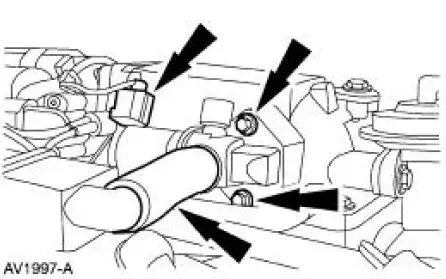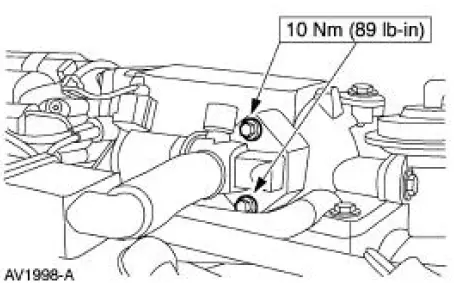Ford Mustang (1999-2004) Service Manual: Idle Air Control (IAC) Valve - 4.6L (2V)
Removal
1. Disconnect the battery ground cable. For additional information, refer to Section.
2. NOTE: Discard the idle air control (IAC) valve gasket.
Remove the IAC valve.
- Disconnect the connector.
- Disconnect the hose.
- Remove the bolts, the IAC valve and the gasket.

Installation
1. To install, reverse the removal procedure.

 Idle Air Control (IAC) Valve - 3.8L
Idle Air Control (IAC) Valve - 3.8L
Removal
1. Disconnect the battery ground cable. For additional information,
refer to Section.
2. NOTE: Discard the idle air control (IAC) valve gasket.
Remove the IAC valve.
Disconnec ...
 Idle Air Control (IAC) Valve - Cobra
Idle Air Control (IAC) Valve - Cobra
Removal and Installation
1. Disconnect the idle air control (IAC) valve electrical connector.
2. Remove the bolts, the IAC valve and the gasket.
3. NOTE: Install a new gasket if necessary.
To i ...
Other materials:
Lock Cylinder - Door
Removal
1. NOTE: Individual lock cylinders are repaired by discarding the
inoperative cylinder and building
a new lock cylinder using the appropriate lock repair package. The lock
repair package includes
a detailed instruction sheet to build the ne ...
Component Tests
Drive Belt Noise/Flutter
Drive belt chirp occurs due to pulley misalignment or excessive pulley runout.
It can be the result of a
damaged pulley or an incorrectly aligned pulley.
To correct, determine the area where the noise comes from. Check each of the
p ...
Link - Stabilizer Bar
Removal
CAUTION: Suspension fasteners are critical parts because they affect
performance of vital
components and systems and their failure can result in major service expense. A
new part with
the same part number must be installed if installation becomes nec ...
